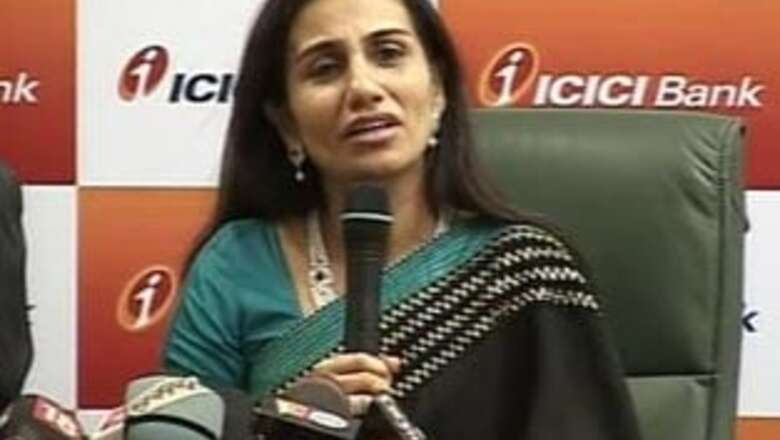
views
The 11th floor conference room in the South Tower at ICICI Bank’s headquarters has witnessed many stormy meetings. Like the one in progress that warm April day in 2008.
KV Kamath’s A-team — Chanda Kochhar, V Vaidyanathan, Madhabi Puri-Buch, K Ramkumar and Sonjoy Chatterjee — had assembled there, a day before presenting the bank’s budget to the board. Kamath had told them they ought to focus on reining in costs.
But a consensus seemed to elude the group. That was because Kochhar, widely tipped to take over from Kamath, was unconvinced. Everybody else in the room reckoned Rs 7,900 crore in operating expenses was a fair number.
The debate went on, until abruptly, Kochhar stood up and said: “With this kind of numbers, we won’t have a bank to run next year.” That said, she called the meeting to a close.
A couple of hours of brainstorming later without Kochhar, they reassembled in the same room. “We don’t have an answer,” executive director and group HR head at the bank K Ramkumar recalls the team telling Kochhar. “What is the number we ought to be working on?” Without blinking, she said “Rs 6,500 crore”.
For a few moments, there was a stunned silence in the room. Essentially, she was telling them to maintain operating expenses at the previous year’s level. For people working in an entity that always grew at 35 – 40 per cent each year, this sounded like harakiri. The next day, Kamath nodded in approval and smiled at the numbers. What in the devil’s name, they wondered, was going on? What, indeed!
A new paradigm
For as long as most people who have followed ICICI can remember, the bank has remained married to one mission: Aggressive growth. That is why when news started trickling out that a divorce is inevitable, we had to ask Chanda Kochhar — who has since taken over from Kamath as the CEO and managing director, if this is indeed the case. Quite honestly, it was impossible to miss the firmness in an otherwise temperate voice. “Growth,” she said, “can mean various things. It isn’t just about growing the balance sheet.”
To seasoned ICICI watchers, this is the kind of language that qualifies for blasphemy — the kind of thing an outsider with no clue of the bank’s institutional history would say. But then, we all know Chanda Kocchar is, The Insider. She’s seen it all: How her predecessor KV Kamath transformed ICICI from a crumbling development financial institution (DFI) to India’s most visible universal bank; how he grew its balance sheet five fold in less than a decade; and how he commands fanatic loyalty from the troops. But everything Kochhar is executing right now may seem to be at loggerheads with what her mentor believed in.
Over the next one year, she intends to grow the balance sheet by just five per cent — an unthinkably low number during the Kamath years. But now, she is battening down the hatches on two of Kamath’s biggest bets — plant the ICICI flag outside India and aggressively woo rural India. For some time to come, Kochhar promises there will be no saber rattling on either of these fronts.
And remember the credit card and personal loan businesses? Kamath goaded the bank into war with global giants Citi and Standard Chartered and eventually toppled them a few years ago. One of the first things Kochhar did after taking over was to tell her colleagues to back off from these verticals and cut losses.
PAGE_BREAK
Then there was this period when Kamath told a whole generation of Indians why visiting a bank doesn’t make sense. Use ATMs instead, he urged. And to sell a credit-starved country all that a modern bank could offer, he recruited an army of direct selling agents (DSA).
It was his way of getting around infrastructural deficiencies that could otherwise hamper ICICI’s growth plans.
Since the time Kochhar has taken over though, the emphasis at ICICI is to get people into branches.
Folks at the bank used to working at its giant headquarters in Bandra Kurla Complex in Mumbai are being redeployed to run branches. And 70 percent of ICICI’s DSA operations have been wound up. By next year, the bank may no longer rely on any outsourcing for business acquisition and collections.
Why, you wonder, is Kamath’s protégé talking in a tongue different to his? Equally puzzling, why does Kamath approve of where she is taking the bank to? What changed?
An unfamiliar world
Last September, soon after Lehman Brothers collapsed, ICICI Bank faced an unprecedented crisis. Speculation mounted that its exposure to Lehman held enough potential to wreck the whole bank. Edgy traders hammered the stock down and nervous depositors queued up outside its premises to take their money back. “It hurt us enormously when nobody believed our exposure was limited to $81 million,” recalls Ramkumar.
To manage the crisis, a war room was set up and the mantle fell on Kochhar to lead the exercise. “It taught me a couple of things,” she says. “One, if there is a challenge, your shoulder ought to become broader and your back straighter. Confidence is important. Two, you have to be the sponge that absorbs stress. Else, it passes down to the team and they cannot function efficiently.”
Be that as it may, much agonising and introspection later, the team concluded there were indeed a few problems on their hands. Mainly, in their attempt to innovate and stay ahead of everybody else, they had gotten too damn aggressive. Or at least that is how the world perceived them now.
It also sensitised the team to a type of risk they hadn’t factored in before — reputation risk. Until then, as bankers, they had only understood market risk, credit risk and operations risk. In some part, this was the outcome of yet another controversial sequence of events in the bank’s history. Just before this crisis played itself out, the team had battled another.
Starting 2007, the bank came under fire in the media for allegedly using strong arm tactics to collect credit card dues. “We perhaps misjudged the power of public perception around collections. And that impaired our ability to collect money,” says Ramkumar. It finally forced the board, led by chairman N Vaghul and Kamath to dismantle the entire network of collection agents.
“As a challenger, being seen as aggressive is fine. But the moment you are a leader, being aggressive is often seen as someone who infringes on other people’s rights. That is not a perception we want to live with,” says Ramkumar. To that extent, the team concluded, unbridled aggression — a leitmotif of the Kamath era — had to be buried.
While it is tempting therefore to assume all of what ICICI is going through now is a function of the Kamath-years that would be missing the point entirely. The point is Kamath has this uncanny knack of seeing things ahead of others. Before anybody else did, he figured that the world was set to change dramatically.
And that if ICICI had to survive the long haul, it would have to slam the brakes on growth and reassess the assumptions on which it was built. That it would hurt, was obvious to him. Which is why, in a signal of solidarity with stakeholders, he declined to accept 300,000 stock options at Rs 400 each, for which he was eligible in December 2008. The team followed suit.
When he had rolled his sleeves up about ten years ago, India’s 200 million strong middle class needed credit to buy cars, homes and everything else. The 8-10 percent economic growth gave them the appetite to go in for big ticket loans. Which is why, by 2007, 65 percent of ICICI Bank’s retail assets were meant for this market. The downturn challenged these assumptions. And the bank’s existing credit models, built on data from the past,was not tuned in to these changes.
PAGE_BREAK
Even as these changes were unfolding, inflation was moving up. In turn, it compelled the central bank to tighten interest rates. Through all of 2007 and 2008, the RBI pushed up interest rates repeatedly. For ICICI, that proved disastrous and exposed another chink in its armour — an over reliance on higher cost bulk deposits. Traditionally, most commercial banks monitor a ratio called CASA. This indicates the percentage of current and savings accounts to total deposits. A higher CASA ratio means the bank has access to cheaper funds. This allows it to earn higher margins when it lends.
The problem can be traced back to 2002 when shortly after the reverse merger between ICICI and ICICI Bank, Kamath realised he had only two options: One, without a branch network to challenge the might of public sector banks, he could stay content with a niche strategy, much like foreign banks. Two, he could go for scale by overlooking the CASA ratio in the short term and focus instead on picking up wholesale deposits at a slightly higher rate. He chose the latter. It made perfect business sense as well in a low interest rate regime. So, while industry benchmarks were at 33 per cent (one third of all deposits coming via CASA), ICICI Bank would touch 30 per cent at the best of times. And when the crisis hit home in October last year and depositors made a run for their money, CASA levels dropped to an alarming 26 per cent.
And if all of this wasn’t enough, the unsecured loans business (largely credit cards and personal loans) started to bleed. Blame it partly on a bad macro-economic environment. And partly on the fact that ICICI’s collection arms, for reasons described earlier, came under intense public scrutiny. At Rs. 9,900 crore, of which almost 80 per cent came from the retail business, the bad loans gave ICICI a dubious sobriquet: It had the highest NPA levels for any Indian bank.
These numbers drove home another lesson: Unsecured credit is perhaps not the best way to build customer relationships. Consider HDFC Bank, its fiercest competitor with which it shares an interesting relationship. When ICICI faced a run on its deposits, Aditya Puri, the MD at HDFC Bank, sent out an email to his people asking them not to poach or accept deposits from ICICI’s clients until the crisis was over. But that is digressing. The credit card base HDFC Bank caters to largely comprises customers from its branch banking business. This means, it has access to their credit history, and therefore they have a decent handle on a customer’s credit worthiness.
CICI, on the other hand, acquired customers using a network of outsourced agents whose revenues were linked to the numbers of clients they got in and not their credit worthiness. Not surprisingly, they threw caution to the wind and up saddled ICICI with customers the bank would much rather not have. It was a vicious circle. “The cost of acquisitions and collections for low transaction items and small ticket loans was also becoming unsustainable,” says Sandeep Bakshi, deputy MD and retail head at ICICI Bank. Not only did the cost of maintaining the direct channel jump as volumes grew, but the pressure on collections added to the costs as well.
Simple back-of-the-envelope calculations showed that each time a customer rolled over his credit card dues, the bank earned a 20 per cent interest. So even with credit losses of around 8 percent, the bank still stood to gain a hefty spread. But very soon, this neat little equation was turned on its head. Losses began to mount. And a larger number of people began to default on their dues. “It was unsustainable,” says Chief Financial Officer N.S. Kannan. All of this wasn’t apparent initially.
Through this period, insiders say there was hell to pay. In a sharply competitive culture, the blame game had begun. And fingers were being pointed at the retail business.
Enter Chanda
Beginning end-January, soon after the board took a call on Chanda Kochhar as Kamath’s successor, she initiated a detailed review of the various businesses the bank is into. And over the next four months, she started putting a plan into place to build a new template for ICICI that looked at variables beyond the balance sheet. “I knew I had to help people understand the other dimensions of growth and the logic behind it,” she says.
PAGE_BREAK
Kamath knew his successor was in for a tough haul and would need the time to settle down and gain the confidence of the team. Which is perhaps why, two months before he stepped down, he made sure he came in a half hour late to work and left an hour earlier in the evening. And immediately after he stepped down as CEO, he took six weeks off from the bank to spend time with his daughter and grand children in Seattle. It was his way of providing space to the new leader.
In any case, he had primed Kochhar for the job well in advance. That nod put Kochhar’s plan to hold operational expenses at previous year’s levels firmly in the saddle and stoked a chain of events over the next couple of months.
Vaidyanathan was given charge of pruning costs on the retail side of the business. Every Friday evening, about 20 senior managers would brainstorm in his room on how it could be done. The ground rules were clear. Nothing was sacrosanct. He told them, they could question anything. If they thought his travel schedule, or that of anybody else, imprudent, it would well be within their rights to raise the flag and call for a review.
Stopping Blame Game
In July last year, Vaidyanathan and Ramkumar addressed senior managers in the retail business. “For the first time, we stood up and admitted publicly we failed in areas like unsecured credit and rural banking,” says Ramkumar. “We got punished for setting business goals ahead of capabilities. But as leaders in ICICI Bank, it is okay to stand up and say we are human, that we don’t lack character. It was done without any embarrassment.”
Both exercises paid off and blunted the edges off a blame game that could have spiralled out of control. If any traces remained, the crisis stoked by Lehman’s collapse in September buried all differences. “It was the best thing that could have happened,” says Ramkumar. The team came together under Kochhar. The first thing it did was to start pulling out of lending. But more recently, after she moved to the corner office in May, a fresh team and a new strategy is making its presence felt.
Take Sonjoy Chatterjee who heads the corporate and international banking business. Until very recently, corporate banking relied on fees from large merger and acquisition deals. Inherently though, this is a lumpy business. When the deal pipeline evaporates, fees follow. To get around the hump, he added a new dimension: Transaction banking. In other words, for all the major clients ICICI services, it now manages their non-fund based businesses as well such as forex requirements and opening letters of credit. In the past, it rarely pitched for such businesses. But now, it does aggressively. Because what it does is provide a layer of predictability to the income stream from corporates. “Using our clout with large corporate clients, we will actively push for such business now,” says Chatterjee.
In part, this was possible because ICICI has just got the licences to open another 580 branches, over the 1,453 it already has. Of these, Kochhar has earmarked 20 for special status as mega branches. These will serve corporate customers as well. In some ways, this is how Axis Bank, State Bank of India and HDFC Bank function.
In the past, ICICI preferred to centralise operations while branches were manned by younger staffers. The outcome was poor turnaround time. The branch staff had little control over the outcome.
In the new dispensation, a premium is being placed on the branches. Veterans from headquarters are being deployed to head them. A considerable amount of authority is being vested on them to solve customer issues at the branch itself. At the same time, the bank is targeting the government sector, and even stock market participants to open current accounts to improve the CASA ratio.
The new branch licences are also a reason to wind down the direct marketing channel, a move that brings with it considerable pain. The channel was built over the years with assiduous wooing of partners. But now that the relationship has to be terminated, there is angst in the system.
“We had to give the better agents sufficient notice, so that they could find alternative employment,” says Ramkumar. “Where there was friction, we had to tell them firmly we had no obligations.”
The branches are now the pivot for any retail lending. “They are the face of the brand in a geography. So we need to ensure we get our best people to man them,” says Sandeep Bakshi. As things stand, these branches will take anywhere between 18-36 months to stabilise.
Her biggest challenge is to meet market expectations. So far, to keep its high growth strategy intact, the bank has had to raise funds from the markets several times. Yet at 7.8 percent, the return on equity (ROE) has been poor. As a result, its market value took a beating.
In his interactions with analysts, Kannan, the group CFO, has promised an ROE of 15 percent over the next three years. That will be tough. Kochhar knows that as well and admits she doesn’t know how the numbers will eventually add up. But the roadmap, she says, is clear.
Part one of the plan involves pushing through the ambitious branch expansion plan without adding to operating costs. Which means, in the current fiscal, Kochhar will be focussed on looking at each item of the profit and loss account and balance sheet; and perhaps restructuring it. She believes she has the time on her hand to do it right now because credit growth is moderate. When growth kicks in, which Kochhar reckons will be next year, the bank will be in a better position to capitalize on it. And finally, in the third phase, focus on unlocking value from subsidiaries.
“There is no alternative,” Kochhar says. “In a way, these are huge structural changes. But we have to implement it. I think the actual results of this will not show for a couple of quarters. But I know from internal reviews we are in the right direction.”
Kannan says he has built a dashboard for his senior colleagues, which captures the key metrics. Every fortnight, the performance is reviewed. Any course correction in strategy and tactics are then implemented quickly. “A lot of building blocks are now in place. I am very confident that people will start seeing the facts a couple of months from now,” says Kochhar.
By all accounts, it will be a delicate balancing act. ICICI is hard-wired to be aggressive. Keeping that instinct at bay will take a lot out of her. Already, public sector banks like SBI are getting aggressive in the home loan market. In the normal course, ICICI would have been right out there, slugging it out for the spoils and enjoying a bloody good fight. But these aren’t normal times at the bank. For at least three quarters, Kochhar needs to prove to the rest of the world that the bank can put its house in order, before it can go out there and do what it does best: Fight.



















Comments
0 comment